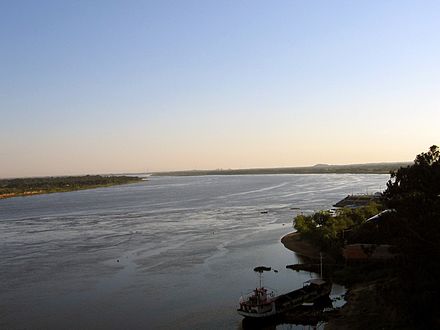Along the Paraguay River - river of Argentina, Brazil and Paraguay

The Paraguay River (Río Paraguay in Spanish, Rio Paraguai in Portuguese) is a major river in south central South America, running through Brazil, Bolivia, Paraguay and Argentina. It flows approximately 2,549 km from its headwaters in the Brazilian state of Mato Grosso to its confluence with the Parana River north of Corrientes. It divides Paraguay into two regions, the oriental and the occidental.
Understand
The Paraguay River was discovered by Alejo García in 1524. It has historically been of vital importance for transportation in South America, because it connects Argentina, Brazil, Bolivia, and Paraguay, as well as other countries throughout the Cuenca del Río de la Plata (Plata River Basin). In absence of roads and routes, the Paraguay River was the fastest and most efficient means of transportation and communication, giving Paraguay, a land-locked country, access to the Atlantic Ocean.
Today, it is not the main transit artery for travel in the area, but is still used for various purposes, especially for the transportation of bulk cargo (crops, minerals, fuel, etc.) and riverside people. Low water level is from March to October; this limits transit to boats of medium or low draft.
Crossing Paraguay, it has numerous tributaries, such as the rivers: Tebicuary, Ypané, Manduviré, Aquidabán, Apa, Confuso, Verde and Montelindo.
Get in
Many of the villages, towns or cities along the river can be reached by bus. The most common ones for tourists might be Bahía Negra and Concepción, in between which the Aquidaban ferry runs.
You can also get in (and out) via Puerto Suárez, Bolivia or Corumbá, Brasil—see Paraguay#By boat.
Get around
As it's a river, boats are really the only option. You can rent a private boat, take a cruise, or ride a cargo boat.
By fishing boat
Fishermen and other locals are keen to offer their boats and canoes as water taxis for tourists. Just ask: even if he's busy, he'll know someone else who will be willing to take you.
By cruise
- Boat Cuñatai. This boat travels short distances in the limits of Asunción. 2019-04-08
By cargo boat
The main long-distance river transport. These general-purpose boats take passengers as well as cargo, though they're not designed for passengers so there are generally no berths; if you're travelling overnight, you'll have to find a level surface to sleep on.
-
Aquidabán Cargo Ferry – Goes between Concepción and Bahia Negra, 4 days upstream, 2.5 days downstream.
-
Fuerte Olimpo-Concepción Ferry – Goes between Concepción and Fuerte Olimpo.
-
Boat Cacique II – Goes between Asunción and Vallemi, 2 days.
See
North to south:
-
Puerto Caballo, -20.1778°, -58.1676°. Located 872 km from Asunción, is in the confluence of the Paraguay River and the Negro (Black) River. This place shares borders with three countries: Brazil, Bolivia and Paraguay. Historically, the surrounding area produced tannin. 2019-04-08
-
Los Tres Gigantes, -20.1842°, -58.1563°. 40 km from Bahía Negra, by the Río Negro, there is this biologic station, which is the first marshland investigation centre in Paraguay, covering 15,000 ha. It is administrated by Guyra Paraguay, an NGO tasked with the defence and protection of biological diversity. 2019-04-08
-
Bahía Negra, -20.2287°, -58.1677°. Located 859 km from Asunción. At certain times of the year, when roads are impassible, it can only be accessed by river or in small planes. The Chamacoco natives live nearby. 2019-04-08
-
Fuerte Olimpo, -21.0375°, -57.870833°. Located 697 km from the capital, in Alto Paraguay Department. It is an attractive and small city with a fort established on a hill. 2019-04-08
-
Isla Margarita, -21.6891°, -57.8888°. This is picturesque island inhabited mostly by fisherman. Across the island, is the Brazilian city of Port Murtinho. Near, there are many Native establishments. It is located 545 km from Asunción. 2019-04-08
-
Vallemi (Small Valley), -22.161°, -57.955°. Located 449 km from the capital. It is the site of Paraguay's main cement factory. This city is also by the Apa River. 2019-04-08
-
Concepción, -23.409°, -57.449°. It is the capital of the department with the same name, 310 km from Asunción. 2019-04-08
-
Asunción, -25.295°, -57.641°. Paraguay's capital city. 2019-04-08
-
Alberdi, -26.185°, -58.145°. This city is across from the Argentine city of Formosa, 133 km from Asunción. 2019-04-08
-
[Pilar](https://pilar.gov.py/), -26.857°, -58.304°. This city is the capital of the Ñeembucú Department, located 301 km from Asunción. Features old buildings in the Spanish colonial style. 2019-04-08
Cope
Not all boats (mostly only the ferries) are equipped with cabins. So, bring a hammock or camping mat with you.
Go next
Onward travel by boat leads to Brazil and Bolivia in the north, or Argentina in the south.